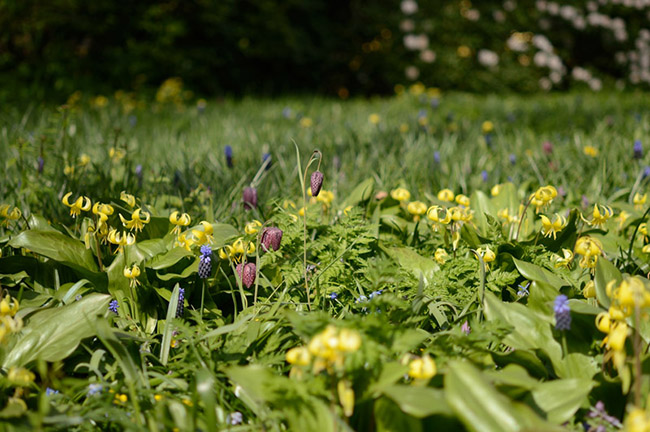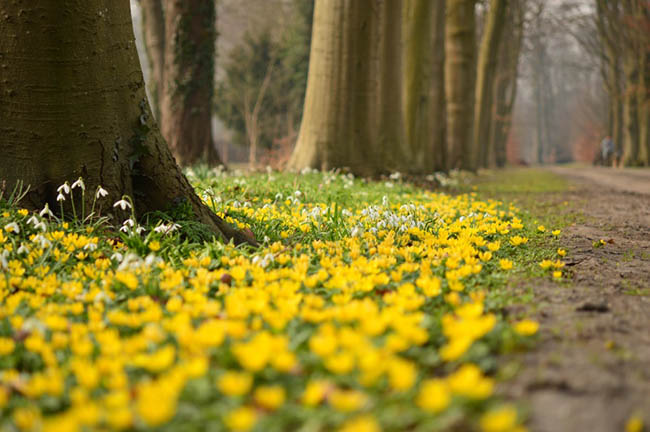Bulbs that are suitable for naturalising are winter hardy bulbs that return every year. These bulbs establish easily and multiply every year.
Nearly all the bulbs, corms and tubers in our assortment are suitable for naturalising. Some bulbs suitable for naturalising are also
stinzenplants.
Always plant bulbs for naturalising where the ground is left undisturbed all the year round, where it won’t be dug over for example. Suitable places are (as with stinzenplants) under deciduous trees and deciduous shrubs, in grassy areas, between perennial plants in borders, or in low growing ground cover such as Lily of the valley, Dead nettle or Periwinkle. Larger areas planted with bulbs for naturalising are a spectacle of colourin spring, for example, grass verges, the edges of golf courses, cemeteries, orchards and along drives.
 Fawn Lily or Dog's Tooth, Snake’s head fritillary and Grape hyacinth naturalised in a grassy area. Photo taken: April.
Fawn Lily or Dog's Tooth, Snake’s head fritillary and Grape hyacinth naturalised in a grassy area. Photo taken: April. When bulbs are planted in grass, make sure the bulbs have set seed before the grass is mown. This is usually 6 weeks after the bulbs have finished flowering. Depending on the flowering time of the bulbs this will be in May or June. The grass can be either extensively maintained (mown once or twice per year) or intensively maintained (mown five times per year or even weekly as a lawn).
It is advisable to
plant the bulbs according to a planting plan. The planting plan doesn’t have to be a botanical top creation; a sketch will suffice as long as you take into consideration the following criteria: the soil type (clay or sand), the position (sunny, shady, moist) and the flowering times of the bulbs. The colour scheme is of course entirely up to you. In our webshop these criteria are listed under each plant description. Please note, a plant description only lists the criteria important to the plant; if one of the criteria happens not to be mentioned then it is for that plant of no particular relevance.
Read more about planting plans and combining bulbs for naturalising with perennial plants in our
bulb planting guide.
Plant bulbs for naturalising in early autumn. Plant the bulbs in an improved soil (click
here for more info about how to improve your soil) and, after flowering is over, don’t cut the dying foliage off! To be sure of a festival of spring colour every year, leave the bulbs to set seed!
 Naturalised bulbs (and also stinzenplants) at Huis te Manpad: Here the bulbs are running delightfully wild and are even encroaching on to the path; the result of three centuries of organic gardening! The plants: Snowdrops and Winter aconites. Photo taken: beginning of March 2013
Naturalised bulbs (and also stinzenplants) at Huis te Manpad: Here the bulbs are running delightfully wild and are even encroaching on to the path; the result of three centuries of organic gardening! The plants: Snowdrops and Winter aconites. Photo taken: beginning of March 2013 Some bulbs, as well as being suitable for naturalising, are also stinzenplants. ‘Stinzenplants’ is essentially a name to describe a collection of historical plants that have been naturalised for centruries around ‘Stinzen’ – a type of Dutch manor house. Stinzenplants are therefore also great for naturalising! (Click
here for more information about stinzenplants)
 Fawn Lily or Dog's Tooth, Snake’s head fritillary and Grape hyacinth naturalised in a grassy area. Photo taken: April.
Fawn Lily or Dog's Tooth, Snake’s head fritillary and Grape hyacinth naturalised in a grassy area. Photo taken: April. Naturalised bulbs (and also stinzenplants) at Huis te Manpad: Here the bulbs are running delightfully wild and are even encroaching on to the path; the result of three centuries of organic gardening! The plants: Snowdrops and Winter aconites. Photo taken: beginning of March 2013
Naturalised bulbs (and also stinzenplants) at Huis te Manpad: Here the bulbs are running delightfully wild and are even encroaching on to the path; the result of three centuries of organic gardening! The plants: Snowdrops and Winter aconites. Photo taken: beginning of March 2013